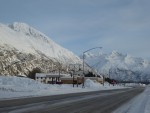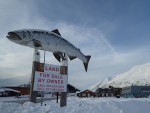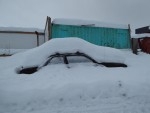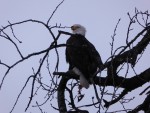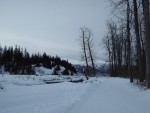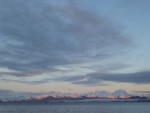
By Gavin Kentch
VALDEZ, Alaska — Sometimes it’s easy to lose sight of the “cross-country” part of cross-country skiing. Particularly in this winter of discontent, when a lot of your training time ends up being spent doing 2.9-kilometer laps around a snowmaking loop.
Sometimes it’s important to travel for five days so that you can spend less than two hours racing, but do so on a course that goes from a mountain overlook to the shores of the Pacific Ocean.
Sometimes, surreally, the country’s second-richest ski race is held in Valdez, Alaska, in the middle of January, and gives away a purse of $10,000 dollars to a field of 36 racers. Sometimes it’s just time to take a road trip with your mom. This is the story of all of those events.
Dramatis personae
Holly Brooks finished her racing obligations in China a few days before this race, returned from China to Washington to visit family, flew back to Alaska on Thursday, then drove to Valdez on Friday before racing the Qaniq Challenge on Saturday. I assume this is basically a normal week for her. Other local athletes carpooled with each other for the over 300-mile drive from Anchorage to Valdez.
Personally, I traveled with my mom, because I am just that cool. (Also, I needed her to chauffeur me across southcentral Alaska: My car is a 1989 Toyota Camry, named Teakettle, which at 27 years old is more venerable than at least half the modern-day World Cup field, not to mention the advent of FIS points. I suspect that Teakettle would literally be unable to drive over Thompson Pass, and so to leave Valdez by road when the weekend was over. And the next ferry back to Whittier wasn’t until a week later.) Her husband, Jim Bouchard, got the other front seat.
Of the three of us, my mother is a good sports mom, who spent my childhood waking up very early on very many occasions to drive me to a variety of endurance sporting events. She once drove six hours one way, in the evening after work, to pick up my little brother after he had been struck by lightning on a solo bike trip outside of Tok, Alaska. My stepfather spent decades living by himself in a log cabin he built off the road system, about 30 miles south of Denali. He was a national age group champion at the 1992 Masters World Cup held in Anchorage. And as for me? Well, not to pull rank, but I have previously been described on this website as “a nothing-special recreational skier.”
‘Getting here is half the challenge’
Valdez is slightly over 300 road miles from Anchorage, a drive of approximately six hours, depending upon winter driving conditions. (This assumes that spectacularly massive avalanches do not close the only road into town for over two weeks.) I decided we should take the ferry there, saving hours’ worth of driving – the ferry leaves from Whittier, a little over an hour’s drive south of Anchorage.
A waterside view of the old apartment building in Whittier, a “city” in the Valdez–Cordova census area of Alaska. As of 2014, the population estimate was 217, according to Wikipedia. The city is also a port for the Alaska Marine Highway and known as the Gateway to Prince William Sound.I may or may not have also harbored fantasies in which an avalanche closed the Richardson Highway the day before race weekend, harming no one, but nonetheless preventing all the real skiers from getting there in time for the race, and then I won the first prize of $3,000 dollars. This did not happen.
My mom and Jim arrived at my house in the predawn darkness on Jan. 14. With some difficulty, we added my skis and ski accoutrements to the car, then carved out space for me in the backseat.
We left my driveway shortly after 9 a.m. It was not exactly light out, but by this point in the year at least sunrise was within an hour. We headed toward the Seward Highway. We had a combined 11 pairs of skis, six pairs of poles, and five pairs of ski boots. Plus snacks. The car was packed. The gas tank was full. Nothing could go wrong.
It was shortly discovered that certain parties had forgotten to pack their wallet, containing, crucially, the state-issued identification necessary to board the ferry. Words were exchanged. A backtrack was undertaken. Houses were returned to. A wallet was obtained, and with it a legitimate form of ID. We set off once more in stony silence, now calamitously late, making plans to do the long drive the next day and ruing the not-small amount of money now wasted on ferry tickets. We decided to try to drive to Whittier anyway, and to hope that the ferry was somehow running late.
We drove down Turnagain Arm under low fog and amber skies, the water in the fjord smooth as glass. Last month, this stretch of road was closed due to 91 mph winds. Also, a semitruck had been blown over on its side and completely off the road. Also, the tunnel that we intended to drive to, in order to reach Whittier, in order to get on the ferry, had been closed.
That did not happen today. We could not see more than 100 feet above the ground as we drove along the Arm, but all the roads were passable. We arrived at the designated snow-plowed field, in seemingly the middle of nowhere, to queue for the 11:30 a.m. opening of the tunnel to Whittier, having long since missed our intended 10:30 a.m. opening, and still assuming that we were about to miss the ferry altogether. At least we could have lunch in Whittier before returning.
(N.B.: I have not fact-checked this final statement. It may literally not be possible to buy a restaurant meal in Whittier on a Thursday in winter. I’ll figure this out next trip.)
We were met by a wonderful sight: a handful of cars sat in the field ahead of us, still waiting for the 10:30 tunnel opening. An Alaska Department of Transportation message board slowly scrolled the reason for the delay: “Please stand by. Tunnel will reopen when smoke is purged.”
I have never been so grateful to drive through an icy, slippery, claustrophobic five-mile long tunnel cut into the mountains that apparently had had rogue smoke in it just a few minutes before.
We emerged, blinking, into the light, and into the town of Whittier, Alaska.
Whittier is a special place. For one, it is the rare settlement that was literally founded where it is because the weather there is always bad. For another, there are virtually no private houses in Whittier; all of the town’s residents live inside the same large apartment building.
For the first few decades of Whittier’s existence, everyone in Whittier lived inside the Buckner Building, a seven-story concrete apartment building erected by the U.S. Army shortly after World War II (see photo above). Later, that building was abandoned.
The new apartment building in Whittier, Alaska.Now everyone lives in the much more colorful Begich Towers, a few hundred yards away from its predecessor. (The concrete hulk of the Buckner Building lives on, standing sentinel over the Valdez waterfront. It gained passing fame a few years ago when two bros descended its asbestos-choked stairwells on downhill skis.) We marveled at the Ghosts of Whittier Past and Present, and drove the car onto the M/V Aurora.
The ferry ride took six hours. It was amazing. The sun was out. Prince William Sound was, atypically, placid and still. Snow-covered peaks shimmered over hillsides of spruce trees cascading down to the water.
At one point, I literally said, “Oh look, yet more dolphins are playing around the bow of the boat. How nice.” I felt like an athlete going over to London for the 1912 Olympics, although there was no track set up on the deck for us to exercise on. And I guess they had fewer glaciers. And more alcohol. Seriously, though, it was probably the most sublime day I have ever spent on a boat in my life.
The M/V Aurora, an Alaska Marine Highway System ferry.Valdez
Valdez is also a special place, though for different reasons than Whittier. It has an average annual snowfall of 300 inches, for one, and two to three times that just up the road in Thompson Pass.
It is also home to the southern terminus of the Trans-Alaska Pipeline System, which undergirds what remains of the state’s suddenly fragile economy. Valdez’s taxes on the pipeline itself make it shockingly wealthy, a lucrative petro-state enclave even within resource-dependent Alaska. (This also explains why Valdez was able to essentially move $10,000 dollars of oil tax money from its own coffers to the pockets of young elite cross-country skiers, which actually feels to me like a pretty positive development.)
A street view in Valdez, Alaska, last month.Standards of what is normal change when you live in such an environment. When I spoke with Qaniq Challenge race director Darryl Verfaillie about ten days before the race, his talk of contingency plans and water drainage made me assume that snow coverage for the race courses was marginal at best.
After inspecting the trails in person after we got to town, I learned that their coverage ranged from a low of one foot of base to a high of at least three feet. As Anchorage suffers through its second low-snow year in a row, Valdez was looking like a pretty good place to be a cross-country skier.
Valdez has also had a relatively snow-sparse winter, at least for Valdez. Therefore, the piles of cleared snow filling spare lots around town were only one to two stories high. These towers stood guard over a neat gridlock of residential streets (Valdez was essentially rebuilt from scratch following the 1964 Good Friday earthquake), where virtually every house was flanked by multiple snowblowers and snowmachines.
Valdez is also the type of place where there are still pay phones. Or maybe not pay phones per se, just telephones in public spaces that permit one to make free calls to anyone else in town. (I don’t know if this institution is common in the states. It persists in Alaska.) It was very pleasant. There was admittedly not too much going on on a Thursday evening in January.
Valdez is also the type of place where there are still pay phones. Or maybe not pay phones per se, just telephones in public spaces that permit one to make free calls to anyone else in town. (I don’t know if this institution is common in the states. It persists in Alaska.)
A royal welcome
I don’t want to be obsequious, but race organizers were beyond accommodating of the skiers. Late on Thursday night, recently arrived in town, I politely emailed the race director, making a tentative inquiry about whether I might be able to find any waxing facilities during the day on Friday. He wrote back at 6:30 a.m. Friday morning, putting me in touch with the local cross-country ski coach (go Valdez Buccaneers!). We were ensconced in the ski team wax room by midmorning.
On multiple occasions, during the middle of the school day, a very clearly not-high-school-age skier walked through the halls of Valdez High School, carrying a large ski bag over his shoulder and bags of waxing supplies in both hands. There were irons, vials, strange powders, an extension cord or two sticking out, and of course the large ski bag. In different contexts, it could be described as suspicious. No one batted an eye.
The royal treatment continued at the Friday-evening racers’ meeting.
“Will there be indoor waxing available tomorrow morning?” someone (me) asked.
“I don’t know, do you want it?” said the race director.
“Uh, yeah,” I said, “if that’s possible, thanks.”
“Okay,” said the RD. “We’ll have someone open the Teen Center for you by 8 a.m.”
And so Jim and I waxed our skis for the classic race inside, warm and dry, with numerous outlets and a bathroom and music. For a ski race on the road, it was paradisiacal.
It was that sort of weekend; everyone could not have been more accommodating. Or maybe I just have really extravagant demands when it comes to ski waxing.
Actual racing: Day 1 (classic)
I previously wrote a real article about the real skiers here. I saw some of these real skiers, if briefly, on race day. Lex Treinen came past me at one point, an unsurprising occurrence in the classic interval start. He was going very, very fast, and even said hi to me by name as he nimbly stepped around me and re-entered the tracks, all while going approximately Mach 9. I had scarcely registered his presence before he was past me. I was impressed.
Trailside view from the classic race course on Day 1 of the Qaniq Challenge.I was also impressed by the army of volunteers and support staff that the race had mustered. I think there were literally as many volunteers and support staff on course as there were racers. Road crossing? They had four people there, including one to hold up traffic on each side, and real, groomed snow across the road.
There was a section where all racers had to do two loops around a 3 k lap, and to help count the number of laps, they had two people at that intersection. One, with a clipboard, counted laps for each racer; the other, with large flags, would direct each racer to head around for another lap or to go back down the course when they approached this junction, as if they were directing an airplane taxiing up to the jetway. If memory serves, I passed six on-course checkpoints during the approximately 15 k race. It was impossible to take a wrong turn.
It was not, however, impossible to fall down. In an impressive display of consistency, I did so twice, once on each lap, in the same place each time. (That place was a six- or seven-foot wide section of trail, presenting the first of two extremely tight corkscrewed turns, with substantial exposure on either side. Alaska is an exciting place to be a ski racer.)
I learned while doing interviews after the race that Tyler Kornfield, an inestimably more talented skier than me, had also fallen twice, in the same place I had. And unlike me, he was wearing skate boots. That made me feel better.
The Pacific Ocean from classic course.After around 50 minutes of skiing, and going from a scenic mountain overlook down to the shores of the Pacific Ocean and back, I approached the finish. I crossed the finish line, immediately began feeling the effects of the longest all-double-pole race in my life, and teetered over to the edge of the finish area to collapse in the snow. I lay on the ground. After a few minutes, I tried to pick my head up, but I was still dizzy, and things were still spinning, so I lay back down. I was not unhappy.
A woman, a local resident who was volunteering with the race, came over. She was wearing a knee-length fur parka that probably cost roughly as much as the entire purse for the weekend’s race. It was one of the most beautiful things I have seen in my life.
She looked down on me not unkindly. “Are you still breathing, hon?” she asked me. I looked up at her. I attempted to form the words, “Thanks, I’m fine.” I met with some success.
It is sort of uncomfortable to sprawl on the ground with one’s skis still on. (Shoutout to my APU Masters coach Galen Johnston, who took my skis off for me unasked while I convulsed on the ground following a recent Besh Cup.)
“Do you think you could help take off my skis?” I said. “Just pull up on the bindings.” She knelt down and began, with great enthusiasm, to pull on my entire foot. “That’s okay,” I said, “don’t worry about it. Maybe you could just help me get up.” This fur-clad vision graciously reached down, gave me a hand, and helped me stand upright again. I was suddenly very conscious of having just finished racing. I tried very, very hard not to get snot, spittle, extruded Apple-Cinnamon Hammer Gel, or any other form of race-induced effluvia on her beautiful jacket.
“Sorry about your boots,” she said. “I’m really more of a hockey mom.”
Eventually, I found my bag, put on every piece of spare clothing I had brought (temps were in the 20s above, but humid maritime cold is cold-cold), and set out for an attempt at a cooldown. I skied part of the way with Holly. At one point, I confessed to her, “I’ve actually never raced on consecutive days before. What do I do in the 23 hours before the next race?” She graciously told me what I should do. Her advice (get warm, dry, and food immediately; active cooldown; warm shower; stretching and jog later that day) was not rocket science, but was much appreciated.
Actual racing: Day 2 (skate)
The start/finish area of skate course at the Qaniq Challenge.Day 2 was a skate race. They took everyone’s first day results, re-seeded the field based on classic time, then had a chevron start for the mass start skate race. There were little numbered placards alongside the tracks in the start area to help everyone line up correctly. It was adorable.
The chevron start, which I may never encounter again in my life, made me feel like a real ski racer. Lining up behind Dylan Watts and Holly did not change this sensation.
The gun went off, and I very quickly felt like less of a ski racer. I guess I’m not very good at starting races fast. Apparently I’m more of an interval-start specialist (says the Masters racer who has done precisely two interval-start races in his life, counting the previous day’s classic race).
Two to three minutes into the race, places #1-4 (the top four guys) were quickly pulling off the front in the lead pack. Places #5-8 (Holly, overall winner Rosie Frankowski, and two male citizen racers) were coming together into a chase pack. I moved up into ninth overall, and took aim at shortening the gap of ten feet that had opened up between me and eighth. In a sudden moment of prescience, I saw the next 45 minutes unfolding before me. I told myself, “You’d better catch this train, or you’re going to spend the entire rest of the race skiing by yourself.”
I did not catch the group. I did ski the entire rest of the race myself. I caught glimpses of the chase pack ahead of me, at greater and greater distances, until as late as 8 k into the race. They were moving very fast, taking turns trading off the lead on a pancake-flat, all-V2 course. They looked like they were having fun. They looked like they were happy. I hoped they were happy.
I was not unhappy; I was skiing, and skiing is fun. But it is more fun when you can see. I think it was colder than I realized; soon my eyes were watering profusely, and I was having a hard time making out the trail, the time on my watch, or anything else.
I had previously been telling myself things like “get forward” and “weight on the balls of the feet,” giving myself technique cues like Jessie Diggins lite (very lite), and at least trying to stay focused while I skied along entirely on my own.
But soon my thoughts became slightly less focused. Like, “my eyes are really cold right now. I really can’t see. I wonder if I’m doing them permanent harm? Like that musher who just got airlifted out of the Kusko 300 sled dog race because she frostbit her eyeball. Is that what’s happening to me right now? Man, I hope I’m okay?” These were understandably valid concerns. They were not particularly effective as technique cues.
(My eyes were ultimately fine. They hurt more when I finished, and again when I shut them to go to sleep that night, and they were bloodshot as hell for a few days later, but that was all.)
I eventually emerged from my solitary ski through the woods and back to the finish line. I did not appreciate it at the time, but apparently they had sent out a PistenBulley during the race to re-groom the start/finish area and take out the set tracks from the chevron start. It was that sort of race weekend.
I crossed the finish line, returned my race bib to Woman in Beautiful Parka, and once more put on every piece of clothing I had brought. This time, it wasn’t enough. I shivered through a ten-minute cooldown, then went inside the old trap range building that had a roaring fire going and served as race headquarters. I stood immediately behind the massive stove, slowly picked the ice out of my thawing beard, and regaled a very patient Dylan Watts with stories of my race while learning what had happened up front. It sure beat getting into Teakettle and turning on the heater that no longer actually produces any appreciable heat whatsoever.
After the race
I headed home for food and a shower. Around the time I was deciding between a nap and writing up my race article, Holly, only furthering her role as worldwide ambassador for cross-country skiing, was back on skis, leading a free clinic for local high school kids. I’m sure this is just what her fellow two-time Olympian Kobe Bryant does for his post-game recovery regimen. (My Holly Brooks hero worship notwithstanding, I should emphasize that she was joined by the rest of the APU Elite Team and associated skiers that were in town, including Frankowski, Lauren Fritz, Paul Kovacs, Dylan Watts, Treinen, and Kornfield. Pretty good day to be a novice skier in Valdez.)
That night, the awards banquet was held in a local bar, The Fat Mermaid. Ten thousand dollars was redistributed from oil money to impoverished elite skiers. Lex and Rosie posed with oversized $3,000 checks.
Awards went five deep per gender. There were also prizes for the fastest locals, and for the fastest skier over 50 (shoutout to my stepfather). That’s 13 awards among 36 racers, or over a third of the field. Also, we all got good pizza, and one free drink ticket each. Also, they had applause not only for the sponsors and volunteers, but also for the press (me). It was a good awards banquet.
Heading the home
The next morning, it was time to go home. It was tough to leave, but we were wrapping up a five-day trip so that I could ski for a combined 101 minutes, so it was probably time. About half the field went backcountry skiing in Thompson Pass on the way home. We headed straight back to Anchorage, so that I could get back to my exceptionally patient wife and our two young girls.
Before we left, we had breakfast at the Totem Inn; poor Jim was yearning for meat after three mornings of oatmeal.
The Totem Inn was very… Alaskan. Of the twenty people in the restaurant on this Monday morning, nineteen of them were men. My mother stood out, because she was the only woman. I stood out, because my race T-shirt, pretty pink sports watch, and choice of tea over coffee clearly marked me as Not An Oilpatch Worker. (My stepfather did not stand out; people who have lived in the woods for three decades also look like they could work at the pipeline terminal.)
The inn’s motto, I have since learned, is, “Where everything about us says, ‘Alaska!’” I applaud their honest marketing.
We hit the road soon after. It was a different experience than the ferry – think six hours of trying to avoid the stench of unwashed ski gear and citrus solvent emanating from the ski bags wedged against my perch in the backseat – but Interior Alaska in midwinter is starkly beautiful, and an amazing contrast to the Sound.
By 4 p.m. I was back home in Anchorage, with its two inches of snow in my front yard, a world away from Valdez and its towering snow piles. By that evening my 3 ½ year old, having heard stories of my race weekend, was playing “cross the finish line and fall down.”
What it all means
Cross-country ski racing is a beautiful, amazing, rewarding, and sometimes surreally random sport. Sometimes your local Masters ski coach turns out to actually be really good at skiing, and goes on to compete in two Olympics. Sometimes your local masters-degree candidate turns out to actually be really good at skiing and shooting, and is racing on the World Cup in her eighth biathlon race ever. Sometimes your local elite skier almost cripples himself in a scary fall in the mountains, then wins a national title six months later. Stuff happens.
Skiing is also, in many ways, an intensely democratic sport. (Let’s elide for a moment the fact that Norway has like a billion World Cup wax techs to the U.S.’s handful – and that’s not counting another dozen or so under the aegis of Great Britain – and that some countries may be more equal than others.)
Sometimes you buy your first-ever race suit secondhand from Holly Brooks, then the next winter find yourself lining up immediately behind her in a mass start race. Sometimes you find yourself double-poling through a gorgeous valley as fast as you can, with the only other skier visible in front or behind you the quickly disappearing form of Lex Treinen. And sometimes, the local high-school kids race against regional high schools one weekend in the Valdez Invite, then against the APU Elite Team the next weekend in the Qaniq Challenge, all on their home course. Skiing is special like that.
***
About the Author: Gavin Kentch lives in Anchorage. He skis with the Alaska Pacific University Masters team, plays with his two adorable daughters, and occasionally works as a solo attorney. He was probably on snow this year before you were.
Author Gavin Kentch (Photo: Krystal Moulton)


